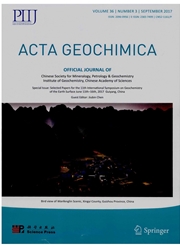

 中文摘要:
中文摘要:
在 Hongge 侵入的中间、上面的部分作为巨大的层发生的 FeTi 氧化物的经济集中在 Emeishan 大火的省与另外的分层的侵入(Panzhihua 和 Baima ) 不同, SW 中国。这份报纸在磁铁矿和钛铁矿的新矿物质作文上报导为选择为暗岩堆积岩石和 clinopyroxene 和斜长石。我们使用这些数据估计父母岩浆并且在矿石形成期间的氧化国家抑制导致涉及 Hongge 分层的侵入的 FeTi 氧化物的丰富的累积的因素。结果证明父母岩浆的氧易逃逸在到 FMQ+0.14 的 FMQ1.56 的范围,并且氧易逃逸在更低的橄榄石 clinopyroxenite 地区( LOZ )和侵入分别地在到 FMQ0.2 和 FMQ0.49 的 FMQ1.29 的范围到 FMQ+0.82 的 Hongge 的中间的 clinopyroxenite 地区( MCZ )在 FeTi 氧化物的矿石形成期间定位了。MELTS 模型表明那,作为易逃逸从 FMQ1 增加到 FMQ+1 的氧,结晶化磁铁矿的比例从 11 增加?%?到 16 ?%和 FeTi 氧化物的结晶化温度从 1134~1164 进展?猯'T匾佩猼扵????猠汯瑵潩?慭?污潳猠敨?楬桧?湯琠敨匠?獩瑯灯?楤瑳楲畢楴湯?湩琠敨匠? 捡畣畭慬楴杮瀠慬瑮s
 英文摘要:
英文摘要:
Economic concentrations of Fe–Ti oxides occurring as massive layers in the middle and upper parts of the Hongge intrusion are different from other layered intrusions(Panzhihua and Baima) in the Emeishan large igneous province, SW China. This paper reports on the new mineral compositions of magnetite and ilmenite for selected cumulate rocks and clinopyroxene and plagioclase for basalts. We use these data to estimate the oxidation state of parental magmas and during ore formation to constrain the factors leading to the abundant accumulation of Fe–Ti oxides involved with the Hongge layered intrusion. The results show that the oxygen fugacities of parental magma are in the range of FMQ-1.56 to FMQ+0.14, and the oxygen fugacities during the ore formation of the Fe–Ti oxides located in the lower olivine clinopyroxenite zone(LOZ) and the middle clinopyroxenite zone(MCZ) of the Hongge intrusion are in the range of FMQ-1.29 to FMQ-0.2 and FMQ-0.49 to FMQ+0.82, respectively.The MELTS model demonstrates that, as the oxygen fugacity increases from the FMQ-1 to FMQ+1, the proportion of crystallization magnetite increases from 11 % to 16 % and the crystallization temperature of the Fe–Ti oxides advances from 1134 to 1164 °C. The moderate oxygen fugacities for the Hongge MCZ indicate that the oxygen fugacity was not the only factor affecting the crystallization of Fe–Ti oxides. We speculated that theinitial anhydrous magma that arrived at the Hongge shallow magma chamber became hydrous by attracting the H_2O of the strata. In combination with increasing oxygen fugacities from the LOZ(FMQ-1.29 to FMQ-0.2) to the MCZ(FMQ-0.49 to FMQ+0.82), these two factors probably account for the large-scale Fe–Ti oxide ore layers in the MCZ of the Hongge intrusion.
 同期刊论文项目
同期刊论文项目
 同项目期刊论文
同项目期刊论文
 期刊信息
期刊信息
